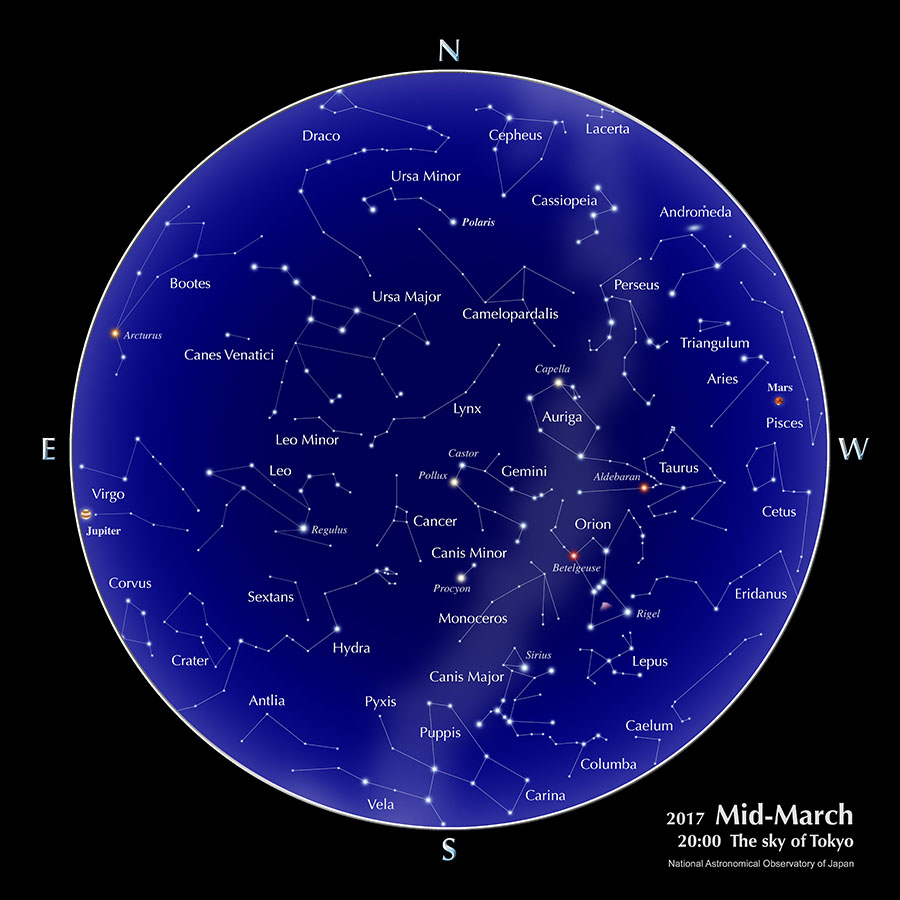The sky of Tokyo, Calendar, Planets (March, 2017)
The sky of Tokyo

Calendar (March)
| 2 | Neptune at conjunction / Venus at stationary point |
| 5 | First Quarter Moon |
| 7 | Mercury at superior conjunction |
| 12 | Full Moon |
| 20 | Vernal Equinox Day [Shunbun-no-hi] (national holiday) / Vernal equinox (Sun’s ecliptic longitude 0°) |
| 21 | Last Quarter Moon |
| 25 | Venus at inferior conjunction |
| 28 | New Moon |
The days for the peak activities of the meteor showers are based on the predictions of IMO(International Meteor Organization).
Planets
- Mercury
- From the beginning to the middle of the month, Mercury is positioned close to the Sun and not suited for observation. Mercury reaches superior conjunction on the 7th, after that it is located low in the western sky after sunset. Its elevation increases at the end of the month, making it easier to see. From March 26 to April 7, its elevation as seen from Tokyo exceeds 10 degrees at 30 minutes after sunset. From March 26 to 31, its brightness is -0.8 to -0.2 magnitude.
- Venus
- Venus shines brightly in the western sky after sunset at the beginning of the month, but its apparent location approaches the Sun, making it difficult to observe. Venus reaches inferior conjunction on the 25th, after that it is positioned low in the eastern sky before sunrise. From the beginning to the middle of the month, its brightness is -4.6 to -4.2 magnitude.
- Mars
- At the beginning of the month, Mars is located in the constellation Pisces and moves east. In the middle of the month, it moves to the constellation Aries. It can be seen in the western sky after sunset. Mars sets around 21:00 as seen from Tokyo. Its brightness is 1.3 to 1.5 magnitude.
- Jupiter
- Located in the constellation Virgo, Jupiter rises in the eastern sky after 20:00 in the beginning of the Month and after 19:00 in the last part of the month as seen from Tokyo. Its brightness is -2.3 to -2.5 magnitude.
- Saturn
- Located in the constellation Sagittarius, Saturn rises in the southeastern sky after midnight as seen from Tokyo. Its brightness is 0.5 to 0.4 magnitude.
Source: Ephemeris Computation Office, NAOJ
With the “Sky Viewer” you can easily explore the appearance of a typical urban night sky (planets and constellations are visible). The Celestial Phenomena section of the glossary explains the planetary phenomena terms: greatest elongation, opposition, conjunction, stationary, etc.